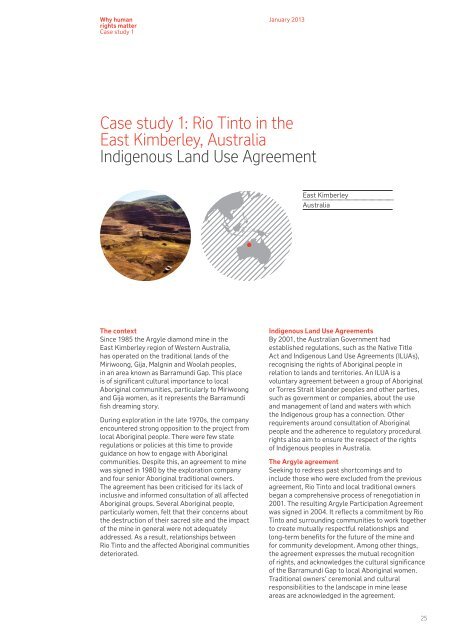Why human rights matter - Rio Tinto
Why human rights matter - Rio Tinto
Why human rights matter - Rio Tinto
You also want an ePaper? Increase the reach of your titles
YUMPU automatically turns print PDFs into web optimized ePapers that Google loves.
<strong>Why</strong> <strong>human</strong><br />
<strong>rights</strong> <strong>matter</strong><br />
Case study 1<br />
January 2013<br />
Case study 1: <strong>Rio</strong> <strong>Tinto</strong> in the<br />
East Kimberley, Australia<br />
Indigenous Land Use Agreement<br />
East Kimberley<br />
Australia<br />
The context<br />
Since 1985 the Argyle diamond mine in the<br />
East Kimberley region of Western Australia,<br />
has operated on the traditional lands of the<br />
Miriwoong, Gija, Malgnin and Woolah peoples,<br />
in an area known as Barramundi Gap. This place<br />
is of significant cultural importance to local<br />
Aboriginal communities, particularly to Miriwoong<br />
and Gija women, as it represents the Barramundi<br />
fish dreaming story.<br />
During exploration in the late 1970s, the company<br />
encountered strong opposition to the project from<br />
local Aboriginal people. There were few state<br />
regulations or policies at this time to provide<br />
guidance on how to engage with Aboriginal<br />
communities. Despite this, an agreement to mine<br />
was signed in 1980 by the exploration company<br />
and four senior Aboriginal traditional owners.<br />
The agreement has been criticised for its lack of<br />
inclusive and informed consultation of all affected<br />
Aboriginal groups. Several Aboriginal people,<br />
particularly women, felt that their concerns about<br />
the destruction of their sacred site and the impact<br />
of the mine in general were not adequately<br />
addressed. As a result, relationships between<br />
<strong>Rio</strong> <strong>Tinto</strong> and the affected Aboriginal communities<br />
deteriorated.<br />
Indigenous Land Use Agreements<br />
By 2001, the Australian Government had<br />
established regulations, such as the Native Title<br />
Act and Indigenous Land Use Agreements (ILUAs),<br />
recognising the <strong>rights</strong> of Aboriginal people in<br />
relation to lands and territories. An ILUA is a<br />
voluntary agreement between a group of Aboriginal<br />
or Torres Strait Islander peoples and other parties,<br />
such as government or companies, about the use<br />
and management of land and waters with which<br />
the Indigenous group has a connection. Other<br />
requirements around consultation of Aboriginal<br />
people and the adherence to regulatory procedural<br />
<strong>rights</strong> also aim to ensure the respect of the <strong>rights</strong><br />
of Indigenous peoples in Australia.<br />
The Argyle agreement<br />
Seeking to redress past shortcomings and to<br />
include those who were excluded from the previous<br />
agreement, <strong>Rio</strong> <strong>Tinto</strong> and local traditional owners<br />
began a comprehensive process of renegotiation in<br />
2001. The resulting Argyle Participation Agreement<br />
was signed in 2004. It reflects a commitment by <strong>Rio</strong><br />
<strong>Tinto</strong> and surrounding communities to work together<br />
to create mutually respectful relationships and<br />
long-term benefits for the future of the mine and<br />
for community development. Among other things,<br />
the agreement expresses the mutual recognition<br />
of <strong>rights</strong>, and acknowledges the cultural significance<br />
of the Barramundi Gap to local Aboriginal women.<br />
Traditional owners’ ceremonial and cultural<br />
responsibilities to the landscape in mine lease<br />
areas are acknowledged in the agreement.<br />
25
















![[PDF] Community Development Toolkit - CommDev](https://img.yumpu.com/48616495/1/184x260/pdf-community-development-toolkit-commdev.jpg?quality=85)
